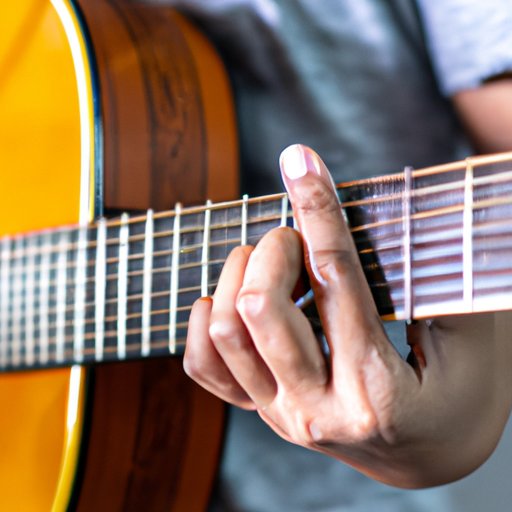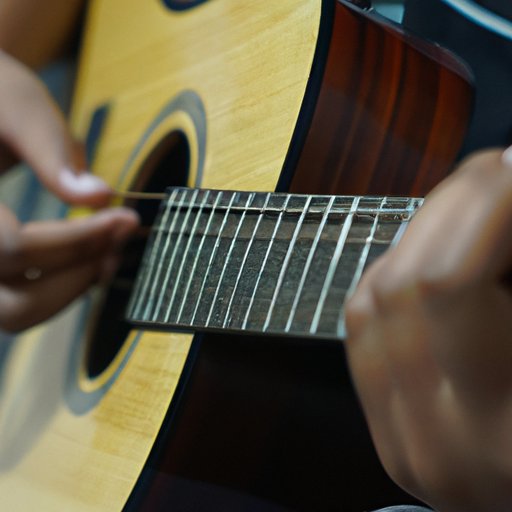
Introduction
Learning to play the guitar can be a fun and rewarding experience, but it can also seem daunting for beginners. In this article, we will provide a comprehensive guide on how to play guitar for beginners, from the basics to more advanced techniques. We will cover essential tips, step-by-step instruction on mastering the basics, transitioning from beginner to intermediate, best resources for learning guitar for free, developing your own style, overcoming common challenges, and mastering the art of strumming.
Before getting started, it’s important to understand the importance of learning the basics, staying motivated, and practicing regularly. As with any skill, progress takes time and dedication, so it’s important to approach learning guitar with patience and a willingness to learn.
7 Essential Tips for Learning Guitar as a Beginner
Whether you’re learning guitar for the first time or picking it up again after a long hiatus, these essential tips will help you get started on the right foot.
Tip #1: Choosing the Right Instrument and Gear
Choosing the right guitar can make a big difference in your playing experience. It’s important to choose an instrument that’s comfortable to handle and fits your playing style. Acoustic and electric guitars differ in terms of sound and playability. If you’re unsure of what to choose, consult with a professional or experienced player.
Additionally, other gear such as picks and tuners can help to improve your sound and playing ability, so consider investing in those as well.
Tip #2: Setting Up a Regular Practice Schedule
Consistency is key when it comes to learning guitar. Set aside a regular time for practice each day or week to make progress and improve your skills. Keep in mind that short, frequent practice sessions are generally more effective than longer, infrequent ones.
Tip #3: Learning Basic Chords and Scales
Chords and scales are the building blocks of guitar playing. Start with basic chords such as G, C, D, and E, and focus on playing them cleanly. Scales can also help to build your finger strength and dexterity, so work on mastering those as well.
Tip #4: Listening to Different Types of Music
Listen to different genres of music to expand your repertoire of songs and playing styles. This can help you to stay motivated and interested in learning the guitar.
Tip #5: Working with a Teacher or Tutor
If possible, consider working with a teacher or tutor to receive personalized instruction and feedback on your playing. They can help to identify areas for improvement and provide guidance on technique. Alternatively, online courses and tutorials can also be helpful for beginners.
Tip #6: Recording Your Progress and Practicing with Others
Recording your progress can help to track your improvement over time and provide motivation to keep practicing. Additionally, practicing with other musicians can help you to improve your timing and rhythm.
Tip #7: Staying Motivated and Having Fun
Lastly, remember to stay motivated and have fun! Playing guitar is a journey, so enjoy the process and experiment with different styles and techniques.
Mastering the Basics: A Step-by-Step Guide to Learning Guitar
Whether you’re a complete beginner or looking to brush up on fundamental skills, these step-by-step instructions will help you to master the basics of guitar playing.
How to Hold and Tune Your Guitar Properly
Before you start playing, it’s important to learn how to hold and tune your guitar properly. Hold the guitar so that it’s snug against your body and the strings are easily accessible. Tuning your guitar is essential to ensure that it sounds good. Use a tuner or a tuning app to adjust your strings to the correct pitch.
Learning Basic Chords, Strumming Patterns, and Picking Techniques
As mentioned earlier, chords are the building blocks of guitar playing. Start with basic chords such as G, C, D, and E, and work on playing them cleanly and effectively. Next, work on strumming patterns and picking techniques to build your rhythm and timing.
Reading and Understanding Chord Charts and Tablature
Chord charts and tablature are written notation systems that indicate which chords to play and where to play them. Learning to read and understand these systems is essential for playing guitar, so take the time to familiarize yourself with them.
Practicing with Metronomes and Backing Tracks
Practicing with a metronome can help to improve your timing and rhythm. Backing tracks are also a great tool for practicing and improvisation.
From Zero to Hero: How to Go from Beginner to Intermediate Guitar Player
Once you’ve mastered the basics, it’s time to take your playing to the next level with more advanced techniques and skills.
Understanding Music Theory and How it Applies to Guitar Playing
Music theory can seem intimidating, but it’s essential for understanding how music works. Learn the basics of music theory and how it applies to guitar playing to take your playing to the next level.
Fingerpicking Exercises and Techniques
Fingerpicking is a technique that involves plucking the strings with your fingers rather than a pick. It can add nuance and depth to your playing, so consider working on fingerpicking exercises and techniques.
Improvisation and Soloing Tips and Tricks
Improvisation and soloing are skills that can take your playing to the next level. Learn how to play around with scales, chords, and keys to create your own unique sound.
Using Different Effects and Pedals to Shape Your Sound
Effects and pedals can help to shape your sound and add depth and nuance to your playing. Experiment with different effects and pedals to find what works for you.
The Best Online Resources for Learning Guitar for Free
Learning guitar doesn’t have to be expensive. There are plenty of free resources available online to help you improve your playing.
YouTube Channels and Tutorials for Beginners
YouTube is a great resource for guitar players of all levels. Look for channels and tutorials specifically tailored to beginners to find helpful tips and guidance.
Free Instructional Websites and Tabs
Websites such as Ultimate Guitar and Songsterr offer free tabs for a wide range of songs. Additionally, there are many websites offering free instructional content such as lessons and tutorials.
Guitar Forums and Communities for Support and Feedback
Guitar forums and communities are a great way to connect with other players, receive feedback on your playing, and find support and motivation.
Developing Your Own Style: How to Find Your Voice as a Guitar Player
Developing your own unique sound and style is important for becoming a well-rounded guitar player.
Experimenting with Different Genres and Types of Music
Experimenting with different genres and types of music can help you find your niche and develop your own style.
Finding Inspiration in Other Guitar Players and Musicians
Listening to and learning from other guitar players and musicians can help to spark creativity and provide inspiration for developing your own style.
Developing Your Own Unique Sound and Style
Take the time to experiment with different techniques and approaches to find your own unique sound and style.

Overcoming Common Beginner Guitar Playing Challenges
Playing guitar can be challenging, especially for beginners. Here are some common challenges and how to overcome them.
Dealing with Hand and Finger Pain
Playing guitar can be tough on your hands and fingers, but there are ways to minimize pain and discomfort. Take breaks as needed and stretch your hands and fingers regularly.
Struggling with Chord Transitions
Chord transitions can be tricky, but they can be mastered with practice. Break down chord changes into smaller parts and practice them slowly.
Staying Motivated and Avoiding Practice Ruts
Staying motivated and avoiding practice ruts is important for maintaining progress. Set achievable goals, take breaks when needed, and constantly challenge yourself with new techniques and skills.
Mastering the Art of Strumming: How to Build Rhythm and Groove on the Guitar
Strumming is an essential part of guitar playing, and mastering different patterns and grooves can take your rhythm playing to the next level.
Understanding Different Strumming Patterns, Accents, and Grooves
Strumming patterns, accents, and grooves can add texture and depth to your playing. Learn different patterns and grooves to expand your playing style.
Developing Good Timing and Flow
Timing and flow are essential for good strumming. Practice with a metronome and focus on keeping a consistent beat.
Experimenting with Different Styles and Approaches to Strumming
Experiment with different styles and approaches to strumming to find what works for you. This can help to expand your playing style and improve your techniques.
Conclusion
Learning to play guitar can be a fun and rewarding experience with the right approach. Remember to keep practicing, stay motivated, and explore different styles and techniques. With dedication and patience, anyone can become a skilled guitar player.





